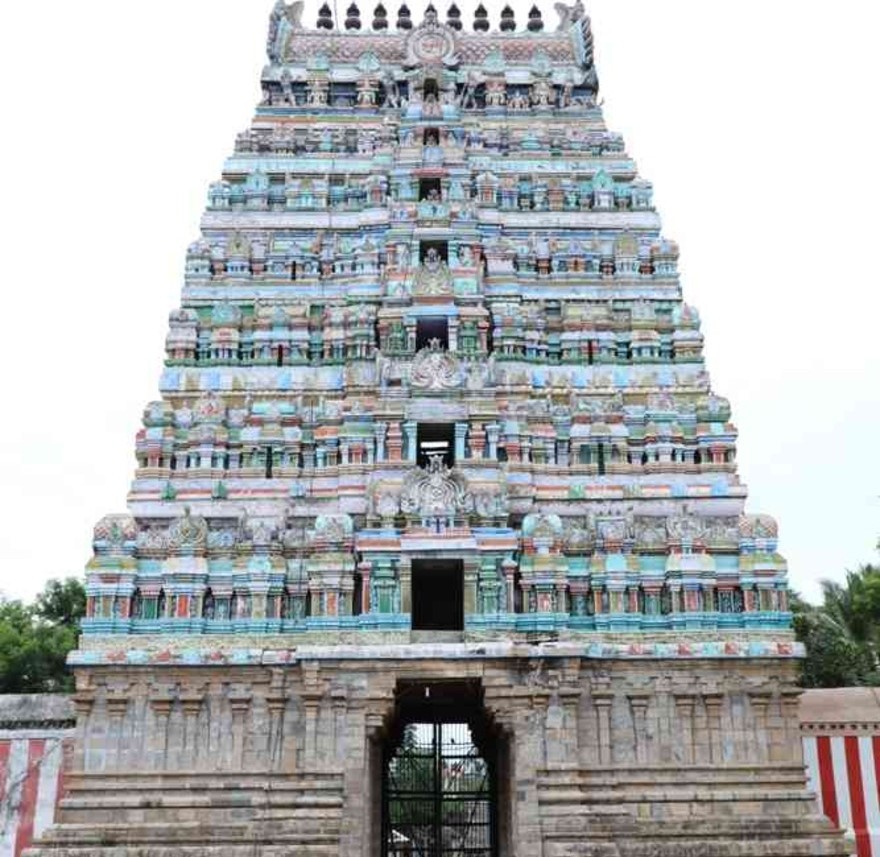Thirunageswaram Naganatha Swamy Temple

Thirunageshwaram Rahu Temple, alternatively referred to as Thirunageswaram Temple, stands as a prominent Hindu temple situated in the charming town of Thirunageswaram within the Kumbakonam region of Tamil Nadu, India. This historic temple is consecrated to Lord Rahu, one of the celestial entities central to Hindu astrology, and it holds a distinguished place among the nine Navagraha temples, each venerating one of the nine celestial planets or grahas.
Architecture of Thirunageshwaram Rahu Temple:
Gopurams serve as the main entrances to the temple. The gopurams at Thirunageshwaram Rahu Temple are notable for their beauty and intricacy. Thirunageshwaram Temple is enclosed by a prakara, a high compound wall that defines the temple’s boundaries. The prakara also features various inscriptions and sculptures.
The temple has a large and sacred temple tank, or pushkarni, within its premises. These tanks are used for ritualistic baths and play a crucial role in temple rituals and festivals. The inner sanctum, or garbhagriha, of the temple is where the main deity, Lord Naganathaswamy, is enshrined. The sanctum is usually a small, dark chamber that symbolizes the cosmic center of the universe.
The temple complex includes various structures for performing rituals, including yagasalas (sacred fire altars) and yajnashalas (places for performing fire ceremonies).
Deities of Thirunageshwaram Rahu Temple:
- Lord Naganathaswamy (Lord Shiva): The main deity of the Thirunageswaram Temple is Lord Naganathaswamy, an embodiment of Lord Shiva. Lord Naganathaswamy is worshipped as a swayambhu (self-manifested) Shivalingam and holds a central place in the temple’s sanctum sanctorum.
- Lord Rahu: The temple is particularly renowned for its association with Lord Rahu, one of the Navagrahas (nine celestial planets) in Hindu astrology. A separate shrine within the temple complex is dedicated to Lord Rahu, who is symbolically represented as a snake deity. Devotees visit this shrine to seek relief from the malefic effects of Rahu in their astrological charts and to appease this celestial entity.
Religious Significance :
The primary religious significance of the temple lies in its role as a place of worship and pilgrimage for individuals who believe in the astrological influence of celestial bodies, particularly Lord Rahu. Devotees visit this temple to seek relief from the malefic effects of Rahu in their birth charts. It is believed that performing rituals and pujas at this temple can mitigate the adverse effects of Rahu Dosha, a malefic condition in one’s astrological chart.
Thirunageswaram Naganatha Swamy Temple Rituals and Festivals:
- One of the most significant rituals at Thirunageswaram Temple is the Rahu Kala Puja, which is performed during the Rahu kala period each day. Rahu kala is considered an inauspicious time according to Hindu astrology, and this puja is performed to ward off negative influences and to seek Rahu’s blessings.
- Annabhishekam is a unique ritual at Thirunageswaram Temple where the deity is bathed with a mixture of rice and jaggery. This offering is believed to bring prosperity and abundance.
Thirunageswaram Naganatha Swamy Temple Timings:
The temple’s visiting hours are from 6:00 AM to 1:00 PM and then from 4:00 PM to 8:30 PM.
How to reach Thirunageswaram Temple:
By Air: The nearest major airport to Thirunageswaram is Tiruchirapalli International Airport, also known as Trichy Airport, situated approximately 100 kilometers away. Upon arriving at the airport, you have the convenience of hiring a taxi or using public transportation to make your way to the temple.
By Train: Kumbakonam Railway Station is the most proximate railway station to Thirunageswaram, offering good connectivity to major cities across Tamil Nadu. Once you disembark at Kumbakonam, a short taxi ride or a local bus journey will take you to the temple, which is situated nearby.
By Road: Thirunageswaram enjoys excellent road connectivity. You can opt for either buses or taxi services to reach the temple. If your journey begins in Kumbakonam, you will find it to be a brief and convenient drive to Thirunageswaram. For those traveling from other cities or towns within Tamil Nadu, the state’s extensive road network is at your disposal for a hassle-free journey to the temple.
